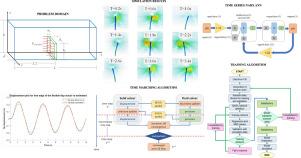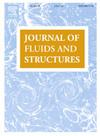利用人工神经网络和流固耦合分区求解器处理流固相互作用时空界面的新方法
IF 3.4
2区 工程技术
Q1 ENGINEERING, MECHANICAL
引用次数: 0
摘要
涉及不规则网格的分区流固耦合(FSI)问题给界面处理带来了巨大挑战,特别是在空间和时间上的信息交换、界面跟踪和求解器之间的场变量插值。这些都需要特别考虑,以实现准确高效的模拟。本文介绍了人工神经网络(ANN)在采用分区求解器的耦合 FSI 问题界面处理中的应用。本文提出了一种浅层时间序列 ANN(具有外生输入的非线性自回归模型,NARX)方案,用于处理耦合界面上的 Neumann/Dirichlet 信息交换。该方案涉及两个已开发和分析的界面处理模型。所提议的模型插值并将载荷从流体域转移到固体域,反之,将位移从固体域转移到非同轴网格间的流体域。为了验证这种方法,我们在三维 FSI 问题上进行了测试,该问题涉及浸没在流体腔中的柔性襟翼的阻尼振动。经过充分训练的 NARX 接口模型展示了可靠的输入输出映射,并准确预测了接口处的瞬态行为。此外,我们还在时域中探索了降阶建模(ROM)的概念。这使我们能够将模型的复杂性降低一半。我们对不同的训练算法进行了评估,以提高拟议方案的效率和性能。研究表明,使用贝叶斯正则化(BR)和莱文伯格-马尔卡特(LM)算法训练的 NARX 网络表现出最佳的准确性,而基于缩放共轭梯度(SCG)的训练方法则提供了更好的计算效率和可接受的准确性。总之,NARX 接口模型具有精确的性能,为需要精确和快速计算的 FSI 问题提供了可行的应用潜力。本文章由计算机程序翻译,如有差异,请以英文原文为准。

A new approach for spatio-temporal interface treatment in fluid–solid interaction using artificial neural networks employing coupled partitioned fluid–solid solvers
Partitioned fluid–solid interaction (FSI) problems involving non-conforming grids pose formidable challenge in interface treatment, especially for information exchange, interface tracking, and field variable interpolation between solvers in both space and time. These demand special considerations for accurate and efficient simulations. This paper presents an application of artificial neural networks (ANN) for the interface treatment in a coupled FSI problem employing partitioned solvers. A shallow time-series ANN (nonlinear auto-regressive model with exogenous inputs, NARX) scheme is proposed to handle the exchange of Neumann/Dirichlet information at the coupling interface. This scheme involves two interface treatment models that were developed and analysed. The proposed models interpolate and transfer loads from the fluid to the solid domains, and conversely, displacements from the solid to the fluid domains between non-collocated grids. To validate this approach, we tested it on a 3D FSI problem, which involved damped oscillations of a flexible flap submerged in a fluid cavity. Adequately trained NARX interface models demonstrate reliable input–output mapping and accurate prediction of transient behaviour at the interface. Additionally, we explored the concept of reduced-order modelling (ROM) in the time domain. This allowed us to reduce the model’s complexity by half. Different training algorithms were evaluated to enhance the efficiency and performance of the proposed scheme. The study demonstrates that NARX networks trained with Bayesian Regularization (BR) and Levenberg–Marquardt (LM) algorithms exhibit the best accuracy, while the scaled conjugate gradient (SCG)-based training method provides better computational efficiency with acceptable accuracy. Overall, the NARX interface models provide precise performance and offer a viable potential for applications in FSI problems requiring accurate and faster computations.
求助全文
通过发布文献求助,成功后即可免费获取论文全文。
去求助
来源期刊

Journal of Fluids and Structures
工程技术-工程:机械
CiteScore
6.90
自引率
8.30%
发文量
173
审稿时长
65 days
期刊介绍:
The Journal of Fluids and Structures serves as a focal point and a forum for the exchange of ideas, for the many kinds of specialists and practitioners concerned with fluid–structure interactions and the dynamics of systems related thereto, in any field. One of its aims is to foster the cross–fertilization of ideas, methods and techniques in the various disciplines involved.
The journal publishes papers that present original and significant contributions on all aspects of the mechanical interactions between fluids and solids, regardless of scale.
 求助内容:
求助内容: 应助结果提醒方式:
应助结果提醒方式:


